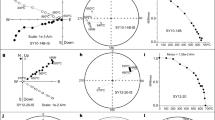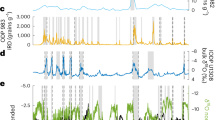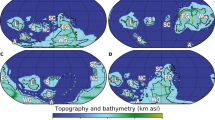Abstract
The relative positions of the continents during the late Precambrian (˜600 Myr BP) are still largely a matter of speculation1. Three reconstructions2–5, based principally on palaeomagnetic and tectonic data, suggest that the continents were joined to form one supercontinent. This supercontinent may have been approximately equatorial2, subpolar to subpolar3,4, or polar to equatorial5 in trend. Here I test these reconstructions by plotting the distribution of the late Precambrian Ediacaran fauna1 and show that the equatorial and subpolar to subpolar models are the most acceptable as templates for metazoan palaeobiogeography.
This is a preview of subscription content, access via your institution
Access options
Subscribe to this journal
Receive 51 print issues and online access
$199.00 per year
only $3.90 per issue
Buy this article
- Purchase on Springer Link
- Instant access to full article PDF
Prices may be subject to local taxes which are calculated during checkout
Similar content being viewed by others
References
1. Glaessner, M. F. The Dawn of Animal Life, A Biohistorical Study, 244 (Cambridge University Press, 1984). 2. Morel, P. & Irving, E. J. Geol. 86, 535–561 (1978). 3. Piper, J. D. A. in The Caledonide Orogen–Scandinavia and Related Areas (eds Gee, D. G. & Sturt, B. A.) 19–34 (Wiley, Chichester, 1985). 4. Piper, J. D. A. Palaeomagnetism and the Continental Crust 384 (Wiley, New York, 1987). 5. Bond, G. C., Nickeson, P. A. & Kominz, M. A. Earth planet. Sci. Lett. 70, 325–345 (1984). 6. Smith, A. G., Hurley, A. M. & Briden, J. C. Phanerozoic Palaeocontinental World Maps 102 (Cambridge University Press, 1981). 7. Hughes, N. F. (ed.) Spec. Pap. Palaeont. 12, 334 (1973). 8. Whittington, H. B. Spec. Pap. Palaeont. 12, 235–240 (1973). 9. Williams, A. Spec. Pap. Palaeont. 12, 241–269 (1973). 10. Glaessner, M. F. in Treatise on Invertebrate Paleontology, Part A (eds Robison, R. A. & Teichert, C.) A79–A118 (University of Kansas Press, 1979). 11. Cope, J. C. W. Nature 268, 624 (1977). 12. Gibson, G. G., Teeter, S. A. & Fedonkin, M. A. Geology 12, 387–390 (1984). 13. Hofmann, H. J., Mountjoy, E. W. & Teitz, M. W. Geology 13, 819–821 (1985). 14. Dyson, I. A. Nature 318, 283–285 (1985). 15. Narbonne, G. & Hofmann, H. J. 4th N. Am. Paleont. Conv. Abstr. A32–A33 (1986). 16. Weiguo, S. Precambr. Res. 31, 325–360 (1986). 17. Anderson, M. M. & Misra, S. B. Nature 220, 680–681 (1968). 18. Misra, S. B. Geol. Soc. Am. Bull. 80, 2133–2140 (1969). 19. Cocks, L. R. M. & Fortey, R. A. /. geol. Soc. Lond. 139, 465–478 (1982). 20. Mayer, A. G. Medusae of the world, III, The Scyphomedusae 499–735 (1910). 21. Campbell, A. C. Guide to the Seashore and Shallow Seas of Britain and Europe 320 (Country Life, London, 1976). 22. Piper, J. D. A. Phil. Trans. R. Soc. A280, 469–490 (1976). 23. Ford, T. D. Proc. geol. Ass. 91, 81–83 (1980). 24. Whittington, H. B. /. Paleont. 40, 696–737 (1966). 25. Eisbacher, G. H. Palaeogeogr. Palaeoclimat. Palaeoecol. 51, 231–254 (1985). 26. McMenamin, M. A. S. Geology 10, 290–292 (1982).
Author information
Authors and Affiliations
Rights and permissions
About this article
Cite this article
Donovan, S. The fit of the continents in the late Precambrian. Nature 327, 139–141 (1987). https://doi.org/10.1038/327139a0
Received:
Accepted:
Issue Date:
DOI: https://doi.org/10.1038/327139a0
Comments
By submitting a comment you agree to abide by our Terms and Community Guidelines. If you find something abusive or that does not comply with our terms or guidelines please flag it as inappropriate.



